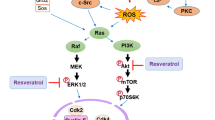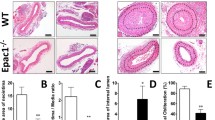Abstract
Purpose
Neointimal hyperplasia (NIH), a pathophysiological event identified in bypass graft and stent re-stenosis, is characterised by aberrant vascular smooth muscle cell (VSMC) migration and proliferation. Recent evidence identifies histone deacetylase modulation as a regulator of VSMC proliferation and migration and a potential therapeutic target in the treatment of NIH. The purpose of our study was to determine the in vitro and in vivo potential of a novel agent, MCT-3, to modulate VSMC migration, proliferation and NIH.
Methods
In vitro VSMC studies utilized reverse transcriptase and real time Q-PCR gene expression analysis, western blot, elisa assay and cellular proliferation and migration scratch assay’s. In vivo studies utilized the partial carotid artery ligation model of NIH together with immunohistochemistry in FVB/N mice.
Results
MCT-3 treatment induced histone H3 and H4 acetylation and inhibited VSMC migration and proliferation in vitro and significantly attenuated NIH in vivo. MCT-3-mediated regulation of orphan nuclear receptor NUR77, Plasminogen Activator Inhibitor Type-1 (PAI-1) and cyclin dependent kinase inhibitors (CDKI) p21CIP1/WAF1 and p27KIP1 expression was also identified.
Conclusions
Together these observations identify a novel agent, MCT-3, with histone deacetylase inhibitory activity, able to inhibit NIH and identify a potential molecular mechanism responsible for these effects. Additional pre-clinical studies may be warranted to determine the potential clinical utility of this compound.






Similar content being viewed by others
References
Mitra AK, Gangahar DM, Agrawal DK. Cellular, molecular and immunological mechanisms in the pathophysiology of vein graft intimal hyperplasia. Immunol Cell Biol. 2006;84:115–24.
Taylor AM, McNamara CA. Regulation of vascular smooth muscle cell growth: targeting the final common pathway. Arterioscler Thromb Vasc Biol. 2003;23:1717–20.
de Vries CJ, van Achterberg TA, Horrevoets AJ, ten Cate JW, Pannekoek H. Differential display identification of 40 genes with altered expression in activated human smooth muscle cells. Local expression in atherosclerotic lesions of smags, smooth muscle activation-specific genes. J Biol Chem. 2000;275:23939–47.
Beauchamp NJ, van Achterberg TA, Engelse MA, Pannekoek H, de Vries CJ. Gene expression profiling of resting and activated vascular smooth muscle cells by serial analysis of gene expression and clustering analysis. Genomics. 2003;82:288–99.
Van Assche T, Hendrickx J, Crauwels HM, Guns PJ, Martinet W, Fransen P, et al. Transcription profiles of aortic smooth muscle cells from atherosclerosis-prone and -resistant regions in young apolipoprotein E-deficient mice before plaque development. J Vasc Res. 2011;48:31–42.
Findeisen HM, Gizard F, Zhao Y, Qing H, Heywood EB, Jones KL, et al. Epigenetic regulation of vascular smooth muscle cell proliferation and neointima formation by histone deacetylase inhibition. Arterioscler Thromb Vasc Biol. 2011;31:851–60.
Horn D. Histone deacetylases. Adv Exp Med Biol. 2008;625:81–6.
Stimson L, Wood V, Khan O, Fotheringham S, La Thangue NB. HDAC inhibitor-based therapies and haematological malignancy. Ann Oncol. 2009;20:1293–302.
Okamoto H, Fujioka Y, Takahashi A, Takahashi T, Taniguchi T, Ishikawa Y, et al. Trichostatin A, an inhibitor of histone deacetylase, inhibits smooth muscle cell proliferation via induction of p21(WAF1). J Atheroscler Thromb. 2006;13:183–91.
Li L, Zhang HN, Chen HZ, Gao P, Zhu LH, Li HL, et al. SIRT1 acts as a modulator of neointima formation following vascular injury in mice. Circ Res. 2011;108:1180–9.
Blackwell L, Norris J, Suto CM, Janzen WP. The use of diversity profiling to characterize chemical modulators of the histone deacetylases. Life Sci. 2008;82:1050–8.
Dear AE, Liu HB, Mayes PA, Perlmutter P. Conformational analogues of Oxamflatin as histone deacetylase inhibitors. Org Biomol Chem. 2006;4:3778–84.
Agrotis A, Saltis J, Bobik A. Transforming growth factor-beta 1 gene activation and growth of smooth muscle from hypertensive rats. Hypertension. 1994;23:593–9.
Neylon CB, Little PJ, Cragoe Jr EJ, Bobik A. Intracellular pH in human arterial smooth muscle: regulation by Na+/H + exchange and a novel 5-(N-ethyl-N-isopropyl) amiloride sensitive Na + and HCO3- dependent mechanism. Circ Res. 1990;67:814–25.
Cakarovski K, Leung JY, Restall C, Carin-Carlson A, Yang E, Perlmutter P, et al. Novel inhibitors of urokinase-type plasminogen activator and matrix metalloproteinase expression in metastatic cancer cell lines. Int J Cancer. 2004;110:610–6.
Nigro J, Dilley RJ, Little PJ. Differential effects of gemfibrozil on migration, proliferation and proteoglycan production in human vascular smooth muscle cells. Atherosclerosis. 2002;162:119–29.
Chomczynski P, Sacchi N. Single-step method of RNA isolation by acid guanidinium thiocyanate-phenol-chloroform extraction. Anal Biochem. 1987;162:156–9.
Korshunov VA, Berk BC. Flow-induced vascular remodeling in the mouse: a model for carotid. Arterioscler Thromb Vasc Biol. 2003;23:2185–91.
Carmeliet P, Moons L, Lijnen R, Janssens S, Lupu F, Collen D, et al. Inhibitory role of plasminogen activator inhibitor-1 in arterial wound healing and neointima formation: a gene targeting and gene transfer study in mice. Circulation. 1997;96:3180–91.
Cullen JP, Nicholl SM, Sayeed S, Sitzmann JV, Okada SS, Cahill PA, et al. Plasminogen activator inhibitor-1 deficiency enhances flow-induced smooth muscle cell migration. Thromb Res. 2004;114:57–65.
Wu J, Peng L, McMahon GA, Lawrence DA, Fay WP. Recombinant plasminogen activator inhibitor-1 inhibits intimal hyperplasia. Arterioscler Thromb Vasc Biol. 2009;29:1565–70.
Gruber F, Hufnagl P, Hofer-Warbinek R, Schmid JA, Breuss JM, Huber-Beckmann R, et al. Direct binding of NUR77/NAK-1 to the plasminogen activator inhibitor 1 (PAI-1) promoter regulates TNF alpha -induced PAI-1 expression. Blood. 2003;101:3042–8.
Huang J, Zhang J, Pathak A, Li J, Stouffer GA. Perivascular delivery of blebbistatin reduces neointimal hyperplasia after carotid injury in the mouse. J Pharmacol Exp Ther. 2011;336:116–26.
Kim YB, Lee KH, Sugita K, Yoshida M, Horinouchi S. Oxamflatin is a novel antitumor compound that inhibits mammalian histone deacetylase. Oncogene. 1999;18:2461–70.
Vinh A, Gaspari TA, Liu HB, Dousha LF, Widdop RE, Dear AE. A novel histone deacetylase inhibitor reduces abdominal aortic aneurysm formation in angiotensin II-infused apolipoprotein E-deficient mice. J Vasc Res. 2008;45:143–52.
Restall C, Doherty J, Liu HB, Genovese R, Paiman L, Byron KA, et al. A novel histone deacetylase inhibitor augments tamoxifen-mediated attenuation of breast carcinoma growth. Int J Cancer. 2009;125:483–7.
Yan ZQ, Yao QP, Zhang ML, Qi YX, Guo ZY, Shen BR, et al. Histone deacetylases modulate vascular smooth muscle cell migration induced by cyclic mechanical strain. J Biomech. 2009;42:945–8.
Dickinson M, Johnstone RW, Prince HM. Histone deacetylase inhibitors: potential targets responsible for their anti-cancer effect. Invest New Drugs. 2010;28 Suppl 1:S3–20.
Liu HB, Mayes PA, Perlmutter P, McKendrick JJ, Dear AE. The anti-leukemic effect and molecular mechanisms of novel hydroxamate and benzamide histone deacetylase inhibitors with 5-aza-cytidine. Int J Oncol. 2011;38:1421–5.
Bonta PI, Pols TW, de Vries CJ. NR4A nuclear receptors in atherosclerosis and vein-graft disease. Trends Cardiovasc Med. 2007;17:105–11.
Pols TW, Bonta PI, de Vries CJ. NR4A nuclear orphan receptors: protective in vascular disease? Curr Opin Lipidol. 2007;18:515–20.
Zhao Y, Bruemmer D. NR4A orphan nuclear receptors in cardiovascular biology. Drug Discov Today Dis Mech. 2009;6:e43–8.
de Waard V, Arkenbout EK, Vos M, Mocking AI, Niessen HW, Stooker W, et al. TR3 nuclear orphan receptor prevents cyclic stretch-induced proliferation of venous smooth muscle cells. Am J Pathol. 2006;168:2027–35.
Arkenbout EK, de Waard V, van Bragt M, van Achterberg TA, Grimbergen JM, Pichon B, et al. Protective function of transcription factor TR3 orphan receptor in atherogenesis: decreased lesion formation in carotid artery ligation model in TR3 transgenic mice. Circulation. 2002;106:1530–5.
Pires NM, Pols TW, de Vries MR, van Tiel CM, Bonta PI, Vos M, et al. Activation of nuclear receptor NUR77 by 6-mercaptopurine protects against neointima formation. Circulation. 2007;115:493–500.
Liu WS, Lin PC, Chang LF, Harn HJ, Shiuan D, Chiou TW, et al. Inhibitory effect of n-butylidenephthalide on neointimal hyperplasia in balloon injured rat carotid artery. Phytother Res. 2011;25:1494–502.
Kim HJ, Kim JY, Lee SJ, Kim HJ, Oh CJ, Choi YK, et al. α-Lipoic acid prevents neointimal hyperplasia via induction of p38 mitogen-activated protein kinase/Nur77-mediated apoptosis of vascular smooth muscle cells and accelerates postinjury reendothelialization. Arterioscler Thromb Vasc Biol. 2010;30:2164–72.
Braun-Dullaeus RC, Mann MJ, Seay U, Zhang L, von Der Leyen HE, Morris RE, et al. Cell cycle protein expression in vascular smooth muscle cells in vitro and in vivo is regulated through phosphatidylinositol 3-kinase and mammalian target of rapamycin. Arterioscler Thromb Vasc Biol. 2001;21:1152–8.
Kee HJ, Kwon JS, Shin S, Ahn Y, Jeong MH, Kook H. Trichostatin A prevents neointimal hyperplasia via activation of Krüppel like factor 4. Vascul Pharmacol. 2011;55:127–34.
Mathew OP, Ranganna K, Yatsu FM. Butyrate, an HDAC inhibitor, stimulates interplay between different posttranslational modifications of histone H3 and differently alters G1-specific cell cycle proteins in vascular smooth muscle cells. Biomed Pharmacother. 2010;64:733–40.
Song S, Kang SW, Choi C, Trichostatin A. Enhances proliferation and migration of vascular smooth muscle cells by downregulating thioredoxin 1. Cardiovasc Res. 2010;85:241–9.
Singh BN, Zhang G, Hwa YL, Li J, Dowdy SC, Jiang SW. Nonhistone protein acetylation as cancer therapy targets. Expert Rev Anticancer Ther. 2010;10:935–54.
Acknowledgments
This research was supported in-part by the Monash University Strategic Grant Scheme.
Author information
Authors and Affiliations
Corresponding author
Electronic supplementary material
Below is the link to the electronic supplementary material.
Supplementary Fig. 1
MCT-3 treatment induced expression of PAI-1 in partially ligated (L) carotid arteries. Confocal equi-exposure images of carotid arteries immunolabelled for PAI-1 (see yellow arrows) 21 days after partial ligation (2 millisecond exposure, x20-40). n = 1–2. (PPTX 128 kb)
Rights and permissions
About this article
Cite this article
Rahmatzadeh, M., Liu, H.B., Krishna, S.M. et al. A Novel Agent with Histone Deacetylase Inhibitory Activity Attenuates Neointimal Hyperplasia. Cardiovasc Drugs Ther 28, 395–406 (2014). https://doi.org/10.1007/s10557-014-6540-y
Published:
Issue Date:
DOI: https://doi.org/10.1007/s10557-014-6540-y




